 ウェブサイト:
Aesculap®/ビー・ブラウン
ウェブサイト:
Aesculap®/ビー・ブラウン
グループ: B. Braun Melsungen
カタログの抜粋

ORTHOPAEDIC SURGERY AESCULAP® Metha® SHORT HIP STEM SYSTEM EVOLVING THE STATE OF ARTHROPLASTY
カタログの1ページ目を開く
AESCULAP® Metha® EVOLVING THE STATE OF ARTHROPLASTY
カタログの2ページ目を開く
CONTENTS SHORT HIP STEM SHORT STEM ANCHORING CONCEPT IMPLANT RANGE LESS INVASIVE APPROACHES IMPLANTATION TECHNIQUE FEMORAL OSTEOTOMIE AND OPENING THE MEDULLARY CAVITY IMPLANT- AND RASP POSITION TRIAL REDUCTION AND STEM IMPLANTATION HANDLES FOR DIFFERENT APPROACHES
カタログの3ページ目を開く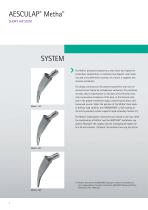
AESCULAP® Metha® SHORT HIP STEM The Metha® prosthesis represents a short stem hip implant for cementless implantation. It combines two Aspects: small stem size and a circumferential coating. As a result, it supports less invasive procedures. The design continues on the positive experience with non-cemented stems fixated by metaphyseal anchoring. The prosthesis concept allows implantation via the base of the femoral neck, with conservative treatment of the bone in the femoral neck and in the greater trochanter region, preserving the bone, soft tissue and muscle. While the position of the...
カタログの4ページ目を開く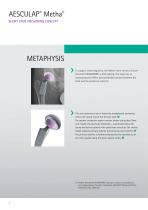
AESCULAP® Metha® SHORT STEM ANCHORING CONCEPT To support osteointegration, the Metha® stem carries a circumferential PLASMAPORE® μ-CaP coating. This layer has an osteoconductive effect and accelerates contact between the bone and the prosthesis stem (1). The non-cemented stem is fixated by metaphyseal anchoring within the closed ring of the femoral neck. 1 The greater trochanter region remains almost untouched. Bone and muscle structures are preserved – a particular bonus for young and active patients with good bone structure. The conical shape supports primary stability and proximal load...
カタログの6ページ目を開く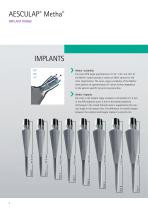
AESCULAP® Metha® IMPLANT RANGE Metha® implants The sizes in the implant range increase in increments of 1.5 mm in the A/P projection and 1.2 mm in the lateral projection. Anchorage in the closed femoral neck is supported by the conical shape in the lateral view. The difference in nominal length between the smallest and largest implant is only 25 mm. Metha® variability The three CCD angle specifications of 135°, 130° and 120° of the Metha® system provide a variety of offset options for the stem implantation. The varus-valgus variability of the Metha® stem position of approximately 20° allows...
カタログの8ページ目を開く
AESCULAP® Metha® LESS INVASIVE APPROACHES Simple and clear instrumentation is a distinguishing feature of the Metha® stem. Because of the more medial location of the femur opening and the medially tilted insertion angle, the Metha® prosthesis is supports minimally invasive and less invasive implantation techniques. The MIOS® (Minimally Invasive Orthopaedic Solutions) instrument range has been specially designed for less invasive procedures and for Metha®. MIOS® retractors, curved instrument profiles and the Metha® rasp handles (see page 20) facilitate all widely used approaches to the hip...
カタログの10ページ目を開く
AESCULAP® Metha® IMPLANTATION TECHNIQUE Indications and bone morphology The Metha® stem is a cementless implant. The spectrum of indications includes degenerative coxarthrosis, rheumatiod arthritis and femoral head necrosis. Good bone quality is a prerequisite for the implantation.Coxa vara bone morphologies and coxa valga dysplasia are also suitable. The pre operative assessment should also take a wide femoral neck, especially in the presence of other concerns regarding the osteotomy level or the implant size into account. An undersized stem could lead to reduced primary stability. Any...
カタログの12ページ目を開く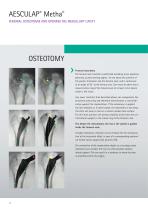
AESCULAP® Metha® FEMORAL OSTEOTOMIE AND OPENING THE MEDULLARY CAVITY Femoral osteotomy The femoral neck resection is performed according to pre operative planning, usually starting approx. 10 mm above the junction of the greater trochanter and the femoral neck, and is carried out at an angle of 50° to the femoral axis. Care must be taken that a closed cortical ring of the femoral neck of at least 2 mm lateral width is left intact. Any lower resection than described above, can compromise the prosthesis anchoring and therefore demonstrates a contraindication against the implantation. If the...
カタログの14ページ目を開く
To position the osteotomy position, the Metha® resection guide or a double osteotomy technique can be used. The Metha® resection guide is placed from anterior direction onto the proximal femur and is guided by the guide rod onto the trochanteric fossa, which needs to be preserved. The attached handle is parallel to the resection guide and should be oriented so that it is also parallel to the axis of the femur. In this position, the osteotomy can be performed. Alternatively or additionally, a double osteotomy can also be performed. A first, subcapital osteotomy can be carried out in situ....
カタログの15ページ目を開く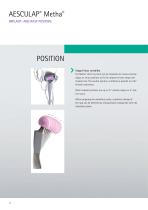
AESCULAP® Metha® IMPLANT- AND RASP POSITION Valgus / Varus variability The Metha® short hip stem can be implanted at various relative valgus or varus positions to fit the respective bone shape and implant size. The neutral position is defined as parallel to a 50° femoral osteotomy. Other implant positions are up to 15° relative valgus or 5° relative varus. When preparing the medullary cavity, a position change of the rasp can be detected by intraoperative comparison with the osteotomy plane.
カタログの16ページ目を開く
Femur preparation The implant bed is prepared in stages, beginning with the smallest rasp. The rasp is introduced centrally into the opening in the medullary canal, observing the antetorsion. During insertion the tip of the rasp should touch the lateral cortex and run along it. To control the tendency towards valgus of the instrument, it helps to apply slight varus pressure when inserting the rasps. The position and alignment of the osteotomy can be checked after inserting the first rasp. Valgus positioning of the rasp can cause unintended leg lengthening. This has to be considered when...
カタログの17ページ目を開く
AESCULAP® Metha® TRIAL REDUCTION AND STEM IMPLANTATION Trial reduction The trial reduction is carried out with modular trial neck adapters, which are clipped on the rasp. There are three neck adapters available with various CCD angles (130°, 135°, 120°). While the different CCD angles of 135° and 130° allow the offset to be changed by -5 mm / +5 mm without changing the leg length, the 120° angle helps the leg length to be adjusted without changing the offset. The medium offset is 44 mm. The appropriate neck adapter is selected by assessing the possibility of a dislocation tendency, the...
カタログの18ページ目を開くAesculap®/ビー・ブラウンのすべてのカタログと技術パンフレット
-
proGAV ® 2.0
36 ページ
-
Targon® FN
36 ページ
-
AESCULAP® NEUROENDOSCOPY
128 ページ
-
Quintex®
8 ページ
-
MONOMAX®
16 ページ
-
Premilene® Mesh Plug
8 ページ
-
AESCULAP® Excia® 12/14
18 ページ
-
Aesculap®
16 ページ
-
VascuFlex®
12 ページ
-
Aesculap Aeos®
16 ページ
-
M.blue®
44 ページ
-
Nelson® deluxe
8 ページ
-
CARDIOLOGY
44 ページ
-
Aesculap® Targon® RF
28 ページ
-
Aesculap® OrthoPilot®
52 ページ
-
TrendHip®
16 ページ
-
proSA®
30 ページ
-
activ L®
44 ページ
-
AdTec® bipolar
8 ページ




































